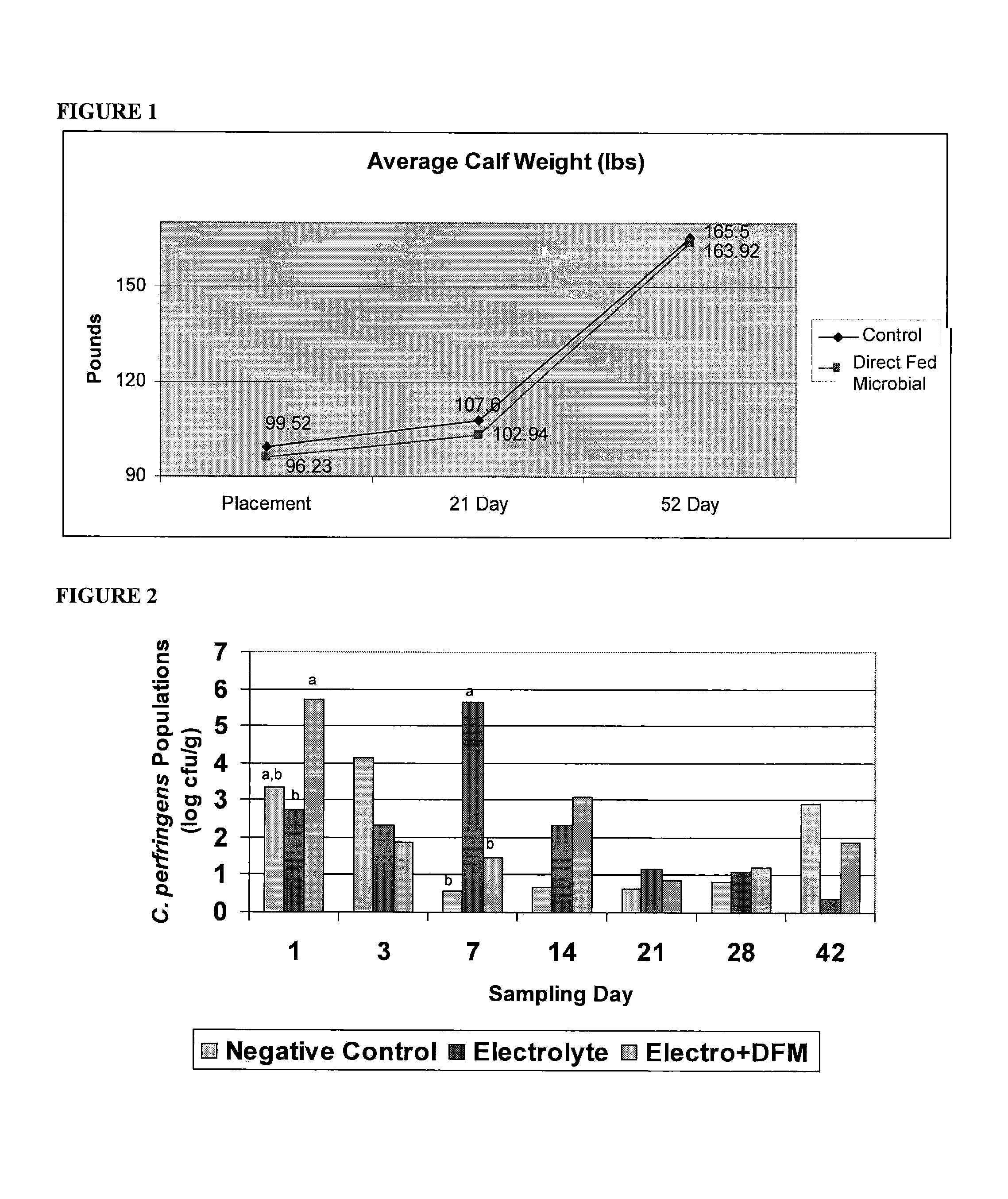Bacillus strains useful against calf pathogens and scours
a bacillus strain and pathogen technology, applied in the field of calf pathogens and scours control, can solve the problems of paucity of data surveying calf and farm level i>c. perfringens /i>prevalence, and the treatment of calf is reduced, and the effect of controlling scours
- Summary
- Abstract
- Description
- Claims
- Application Information
AI Technical Summary
Benefits of technology
Problems solved by technology
Method used
Image
Examples
example 1
[0042]Introduction.
[0043]Clostridium perfringens Type A, pathogenic E. coli, and Salmonella spp. have been associated with scours in calves; however, there is a lack of data characterizing the bacterial genotypes of these pathogens in calves. Therapies and prophylaxes are available for these bacterial pathogens; however, these products typically were either not designed specifically for reducing these pathogens or were designed against only a few isolates.
[0044]Materials and Methods.
[0045]A survey of C. perfringens, pathogenic E. coli, and Salmonella spp. in calves was performed with the objectives of assessing prevalence and genotypes of these pathogens. Genotyping results were utilized to develop a Bacillus-based direct fed microbial (DFM) that inhibited a broad range of C. perfringens virulent E. coli, and Salmonella spp. 705 fecal swabs and 108 gastrointestinal tract samples were collected from scouring calves in California, Iowa, Ohio, Pennsylvania, Washington, and Wisconsin. R...
example 2
[0048]Summary:
[0049]A direct-fed microbial including Bacillus strains 3AP4, 22C-P1, and LSSAO1 was administered in milk replacer to calves in a first group receiving the direct-fed microbial and compared to calves in a second group not fed the direct-fed microbial (the control group). Calves fed the direct-fed microbial tended (pClostridium perfringens type A as noted in 112 fecal swabs, despite 25% of randomly pulled swabs indicating presence of the disease. Swabs did not detect Clostridium perfringens type B, C or D or Salmonella. Only two calves noted incidence of virulent strains of E. coli. Impact might have been greater with significant incidence of Salmonella or E. coli. Also, it is worth noting the calves in the group receiving the direct-fed microbial started significantly less in weight at placement (p<0.06) and trended lower at 21 days (p<0.175). Its remarkable weight gain advantage was +3 lbs for calves in the group receiving the direct-fed microbial versus the calves in...
example 3
[0060]Summary:
[0061]Supplementation of a commercial electrolyte product with a Bacillus-based direct-fed microbial (DFM) at the onset of scours increased gain, reduced C. perfringens fecal shedding, reduced therapeutic medication expenditures, and enhanced immune development in dairy calves. Scours promoted the development of a more mature immune system; however, supplementation with the DFM seemed to further enhance development of the T cell repertoire later in the study. The DFM also alleviated the inflammation from scours earlier than with electrolyte alone; however, both electrolyte treatments decreased inflammatory cell populations later in the study, allowing more energy for growth at this time point. Finally, the DFM altered immune cell populations in scouring calves to resemble those of non-scouring calves. This immunomodulation coincided with a decrease in C. perfringens fecal shedding in scouring calves during week one to concentrations similar to those witnessed in the fe...
PUM
 Login to View More
Login to View More Abstract
Description
Claims
Application Information
 Login to View More
Login to View More - R&D
- Intellectual Property
- Life Sciences
- Materials
- Tech Scout
- Unparalleled Data Quality
- Higher Quality Content
- 60% Fewer Hallucinations
Browse by: Latest US Patents, China's latest patents, Technical Efficacy Thesaurus, Application Domain, Technology Topic, Popular Technical Reports.
© 2025 PatSnap. All rights reserved.Legal|Privacy policy|Modern Slavery Act Transparency Statement|Sitemap|About US| Contact US: help@patsnap.com

